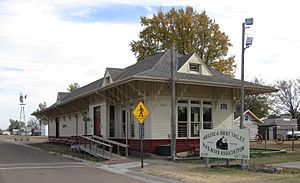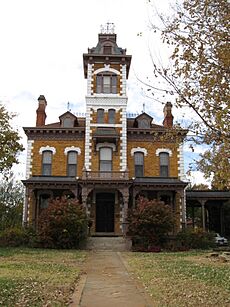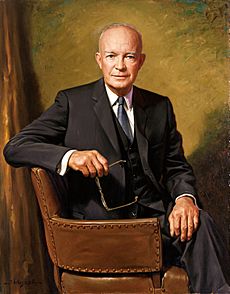Abilene, Kansas facts for kids
Quick facts for kids
Abilene, Kansas
|
|
|---|---|
|
City and County seat
|
|
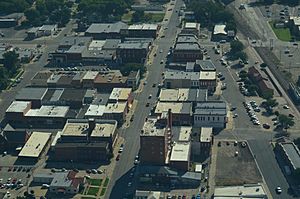
Aerial view of Abilene (2013)
|
|
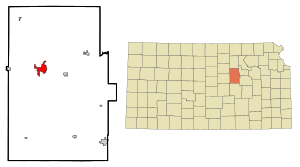
Location within Dickinson County and Kansas
|
|
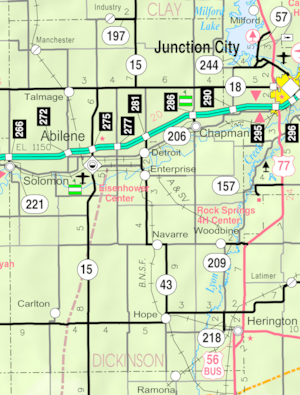
|
|
| Country | United States |
| State | Kansas |
| County | Dickinson |
| Founded | 1857 |
| Incorporated | 1869 |
| Named for | Luke 3:1 (bible) |
| Government | |
| • Type | Mayor–Council |
| Area | |
| • Total | 4.76 sq mi (12.34 km2) |
| • Land | 4.76 sq mi (12.33 km2) |
| • Water | 0.00 sq mi (0.01 km2) |
| Elevation | 1,145 ft (349 m) |
| Population
(2020)
|
|
| • Total | 6,460 |
| • Density | 1,357.1/sq mi (523.5/km2) |
| Time zone | UTC-6 (CST) |
| • Summer (DST) | UTC-5 (CDT) |
| ZIP code |
67410
|
| Area code | 785 |
| FIPS code | 20-00125 |
| GNIS ID | 485539 |
Abilene (pronounced AB-uh-leen) is a city in Kansas, United States. It is the main city of Dickinson County. In 2020, about 6,460 people lived there. Abilene is famous for being the home of the Dwight D. Eisenhower Presidential Library and Museum, which honors former U.S. President Dwight D. Eisenhower. It also has the Greyhound Hall of Fame.
Contents
History
Early Days
For thousands of years, Native American tribes lived on the land that is now Kansas. In 1803, the United States bought most of modern Kansas as part of the Louisiana Purchase. Kansas became the 34th U.S. state in 1861.
In 1857, Dickinson County was created. Abilene started as a stagecoach stop that same year, first called Mud Creek. In 1860, it was named Abilene, from a Bible passage (Luke 3:1), meaning "city of the plains."
The Cow Town Era
In 1867, the Kansas Pacific Railway (part of Union Pacific Railroad) built tracks through Abilene. That same year, Joseph McCoy bought land near Abilene. He built a hotel, cattle pens for 2,000 cows, and stables. The railroad added a special track in Abilene for loading cattle onto trains. The first train with 20 carloads of cattle left on September 5, 1867, heading to Chicago. Abilene quickly grew and became the first "cow town" in the American West.
McCoy encouraged Texas cattlemen to bring their herds to Abilene. From 1867 to 1871, the Chisholm Trail ended here. This brought many travelers and made Abilene a very lively town. The cattle pens shipped 35,000 cows in 1867. They became the largest cattle shipping point west of Kansas City, Kansas. In 1871, between 600,000 and 700,000 cows were herded to Abilene and other Kansas railheads. As more railroads were built further south, the end of the Chisholm Trail moved away from Abilene.
Town Marshals
The town marshal, Tom "Bear River" Smith, was good at keeping order in Abilene. He often used only his bare hands. He was killed on November 2, 1870. Smith was replaced by Wild Bill Hickok in April 1871. Hickok's time as marshal was short. During a street fight, a gambler named Phil Coe shot at Hickok. Hickok shot back, killing Coe. But Hickok then accidentally shot his friend and deputy, Mike Williams. Hickok lost his job two months later.
Later 19th Century
In 1880, Conrad Lebold built the Lebold Mansion. Lebold was an important early town developer and banker. The house is now a private home. A marker outside says the town's name was chosen by opening a Bible and pointing to the first place name seen.
In 1887, the Atchison, Topeka and Santa Fe Railway built a branch line through Abilene. This railroad later merged and is now called BNSF Railway. Many locals still call it the "Santa Fe."
In 1890, Dr. A.B. Seelye started the A.B. Seelye Medical Company. Seelye created over 100 products, including "Wasa-Tusa," which means to heal in an Indian language.
20th Century
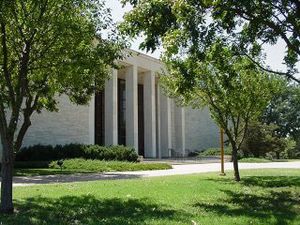
Abilene became the home of Dwight D. Eisenhower when his family moved there in 1892. Eisenhower went to elementary and high school in Abilene, graduating in 1909. The Dwight D. Eisenhower Presidential Library and Museum is where President Eisenhower, his wife Mamie, and their first son Doud Dwight are buried.
Geography
Abilene is located in north-central Kansas. It sits on the north side of the Smoky Hill River. Mud Creek, a smaller stream, flows south through the city into the Smoky Hill River. Abilene is about 27 miles (43 km) east of Salina, Kansas. It is also about 94 miles (151 km) north of Wichita and 139 miles (224 km) west of Kansas City.
The city covers about 4.68 square miles (12.12 km2) of land.
Climate
Abilene has hot, humid summers and cold, dry winters. Temperatures can range from below 20°F (–7°C) in January to almost 95°F (35°C) in July. It often reaches 90°F (32°C) about 66 days a year. The temperature drops to freezing or below about 116 days a year.
The area gets almost 33 inches (84 cm) of rain each year. Most of this rain falls in May and June. Winter snowfall averages about 14 inches (36 cm). The hottest temperature ever recorded in Abilene was 113°F (45°C) in 1954. The coldest was –24°F (–31°C) in 1989.
Economy
Abilene is still a town where cattle are loaded onto trains. It also ships grain and other crops.
The city is also the birthplace of Sprint Telecommunications.
Demographics
| Historical population | |||
|---|---|---|---|
| Census | Pop. | %± | |
| 1880 | 2,360 | — | |
| 1890 | 3,547 | 50.3% | |
| 1900 | 3,507 | −1.1% | |
| 1910 | 4,118 | 17.4% | |
| 1920 | 4,895 | 18.9% | |
| 1930 | 5,658 | 15.6% | |
| 1940 | 5,671 | 0.2% | |
| 1950 | 5,775 | 1.8% | |
| 1960 | 6,746 | 16.8% | |
| 1970 | 6,661 | −1.3% | |
| 1980 | 6,572 | −1.3% | |
| 1990 | 6,242 | −5.0% | |
| 2000 | 6,543 | 4.8% | |
| 2010 | 6,844 | 4.6% | |
| 2020 | 6,460 | −5.6% | |
| U.S. Decennial Census 2010-2020 |
|||
2020 Census
The 2020 United States census counted 6,460 people in Abilene. There were 2,797 households and 1,675 families. About 23.1% of the population was under 18 years old. The median age was 42.3 years.
2010 Census
As of the 2010 census, there were 6,844 people living in the city. There were 2,878 households. About 31.1% of households had children under 18. The average household size was 2.33 people. The median age was 39.6 years.
Education
The public schools in Abilene are part of the Abilene USD 435 school district.
Transportation
Interstate 70 and U.S. Route 40 run together just north of Abilene. They cross highway K-15, which goes north and south through the city.
The Abilene Municipal Airport is on the southwest side of the city. It is mainly used for small planes.
The Kansas Pacific (KP) line of the Union Pacific Railroad runs east-west through Abilene. It connects with a BNSF Railway line.
The city of Abilene also offers on-demand transportation services.
Media
Abilene has one daily newspaper, The Abilene Reflector-Chronicle.
Radio
Abilene has a few local radio stations:
- KABI (1560 AM) plays adult standards music.
- K231AW (94.1 FM) plays Christian radio music.
- KSAJ-FM (98.5 FM) plays oldies music.
Television
Abilene is part of the Wichita-Hutchinson, Kansas television market.
Points of Interest
- Abilene and Smoky Valley Railroad - This is a fun tourist train ride. It starts at the old Rock Island train depot in Old Abilene Town and takes passengers between Abilene and Enterprise.
- Eisenhower Presidential Center and the Dwight D. Eisenhower Presidential Library and Museum - This center honors President Dwight D. Eisenhower. It has murals showing his life, painted by artists Louis George Bouché and Ross Moffett.
- Great Plains Theatre - This building was originally a church built in 1881. Now, it is a live professional theater and movie theater.
- Greyhound Hall of Fame - Located near the Eisenhower Presidential Library, this hall shows the history of the greyhound dog breed and greyhound racing.
- Heritage Center of Dickinson County - This center has two museums: the Historical Museum and the Museum of Independent Telephony. The telephony museum tells the story of C. L. Brown, whose phone company grew to become Sprint Corporation and then T-Mobile.
- Lebold Mansion - This historic house was built in 1880 in the Italianate Tuscan villa style. It was once a museum but is now a private home.
- Old Abilene Town - This area was built to look like a historic district from the old west. It includes several original buildings that were moved here.
- A. B. Seelye House and Museum - This large Georgian-style mansion was built in 1905. It has 25 rooms with original furniture and light fixtures. The Patent Medicine Museum inside shows items from A.B. Seelye's medical company.
- Kansas Historical Marker - There is a marker called Historic Abilene on South Sixth Street.
Cultural
The old "cowboy" days of Abilene are featured in the 1946 film Abilene Town. This movie also inspired the 1963 hit song "Abilene" by George Hamilton IV.
Notable people
President of the United States and five-star general Dwight D. Eisenhower grew up in Abilene. His brothers Edgar, Earl, and Milton also lived there. Eisenhower is buried in Abilene with his wife Mamie and their oldest son Doud.
Other notable people who have lived in Abilene include:
- C. Olin Ball, food scientist and inventor
- Harry Beaumont, film director
- Joseph Burton, U.S. Senator from Kansas
- Steve Doocy, journalist and author
- Joe Engle, pilot and NASA Astronaut
- Marlin Fitzwater, former Press Secretary for Presidents Ronald Reagan and George Bush
- Edward Little, U.S. Representative from Kansas
- Deane Malott, university leader
- Frank Parent, California court judge
- Mike Racy, sports commissioner
- Everett Stewart, World War II flying ace
- Hy Vandenberg, Major League Baseball pitcher
- Cody Whitehair, football player for the Chicago Bears
Sister cities
 Omitama, Ibaraki, Japan
Omitama, Ibaraki, Japan
Images for kids
See also
 In Spanish: Abilene (Kansas) para niños
In Spanish: Abilene (Kansas) para niños


